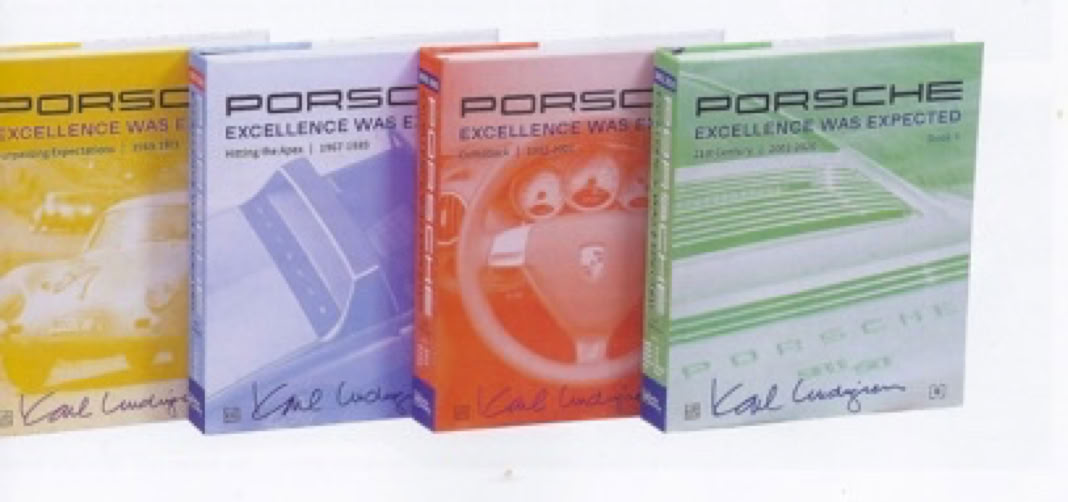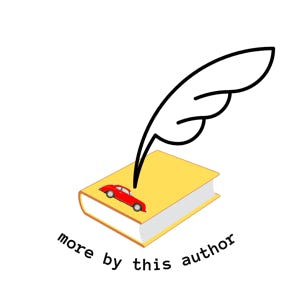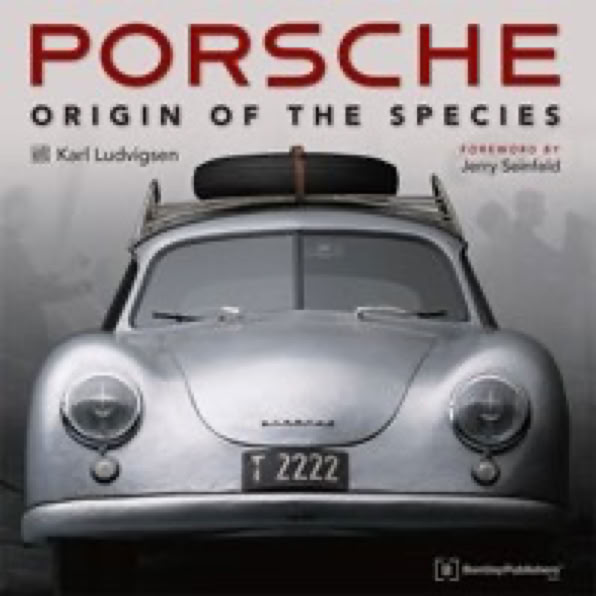TITLE Ferdinand Porsche Genesis of Genius
AUTHOR Ludvigsen
English
ISBN 10 NO ISBN 10
ISBN 13 9780837613345
NO LONGER IN STOCK @ BLOCKS BOOKS— PUBLISHER MAY REPRINT, WATCH FOR UPDATES

FROM MY REVIEWS IN THE 356 REGISTRY:
Forthcoming are Ferdinand Porsche Genesis of Genius and Porsche Spyders 1956-1964 Typ 550A, RSK, 718, both by Ludvigsen. A representative chapter of Genesis of Genius, covering the Prince Henry trials and Porsche’s tulip bodied cars has absolutely the most amazing period photographs. I am astounded that there is still so much unpublished information and photographs. It remains to be seen how much more information it contains than Thiriar’s Porsche Epic Volume 1 – a book which though available in English, was never distributed here. Genesis of Genius is both large & a large format book done to the highest standards. As well it should be with a list price of $200. It was commissioned by no one less than Ferdinand Piech in honor of his grandfather.
FROM MY REVIEW OF THE ORIGINAL EDITION:
There is one book every Porsche enthusiast should own. It’s by Ludvigsen; it’s Porsche Excellence was Expected, not Porsche Genesis of Genius. However -- having established that-- if you are interested in the Ferdinand Porsche and his work and the background prior to the foundation of Dr. Ing. h.c. F. Porsche GmbH, this is the book for you. There is also the similar, and much less expensive, Porsche Epic Volume I, by Thiriar, but it unfortunately has never been distributed in the US.
Porsche Genesis of Genius is a large format (9 ½ by 12”), 485 page, beautifully produced book, has been initially issued as a numbered, boxed book, at an extremely expensive $274.95. While it is to be available as a very expensive standard edition, queries to the publisher were met with “price not determined” and that it would not be available for the Christmas book season. Except for a series of eight modern, color airbrush cut-away drawings by Wolfgang Frankle, the book is entirely composed of period contemporary photographs and technical drawings – no modern photographs at all. In fact the majority of the book is comprised of photographs and drawings, including 100 year old absolutely sharp two page photographs; however, this is not a coffee-table book. It is written in Karl Ludvigsen’s erudite and learned style. By using words including “interregnum” Karl has clearly violated the “aim for 8th grade literacy reading” rule – lip readers need not apply.
Chronologically arranged, the book starts with Porsche at the Lohner factory and its presentation at the 1900 Paris exposition, segueing to a quick historical biography of Ferdinand Porsche, including his having siblings, Oscar and Anna. I can’t help but wonder if either had children and if so were they were also gifted? Ludwig Lohner recognized that his coach-building corporation needed to move with the times and selected Porsche for his electrical expertise to create the Lohner-Porsche. With battery technology even now not where it needs to be, it is not surprising that Porsche quickly moved to gas-electric mixte technology. It was Porsche’s genius that enabled the integration of a gas motor and electric drive – possibly only 356 Electrics expert, Joe Leoni can understand the astoundingly complex circuitry Porsche devised to eliminate batteries and still provide a seamless drive.
The photographs are frequently amazing. I am especially taken by one with depicting Porsche in the Lohner Mixte in full speed approaching a hairpin turn at the 1902 Exelburg Hill climb; on one side is a touring car gently motoring downhill having passed the hairpin, and on the other is a horse-drawn coach approaching! Apparently closing the road to vehicles other than participants had not occurred to anyone. It can be safely assumed that Lohner was the first to discover Porsche’s technical brilliance, coupled with his ability to beggar his employer. Porsche was always moving onto the next challenge: when he left Austro-Daimler he took with him his Austro-Daimler mixte car – a gasoline motor with an electric automatic transmission, that he continued to modify. He also took it when he left Mercedes-Benz. Having moved on to new challenges, he finally just left it at Steyr when he departed that company. After several attempts to return it, Steyr donated it to the Vienna Technical Museum, where it may still be seen.
Later, Camillo Castiglioni (who had forced Porsche out of Austro-Daimler), when asked by Mercedes for a reference, wrote “You can take Porsche on, he is a brilliant man. But you will have to put him in a cage with seven locks. That’s the best place to leave him to draft his engine designs. But he will have to pass his drawings through the bars so that, with luck, he won’t be able to get his hands on the drawings or the engines again!” This is the flip side of the Porsche view -- a manufacturer could live on Porsche’s designs for the next 10 years, but without Porsche.
Porsche’s brilliant designs for World War I artillery “Zugs” bring forth the information, new at least to me, that they were all different and none had a motor-wheel.” Not well known are Porsche’s aero designs including a beyond the state-of-the-art aerial observation platform with mixte drive – a sort of prototype helicopter. Karl points out that a motor touted as a predecessor of our beloved flat four is in fact two conjoined V-2s and may not actually be a Porsche design. Additionally, he gives a new twist on the well known story that while at Mercedes-Benz, Porsche was unable when challenged, to start any one of 15 of his 8/38 small Mercedes on a winter morning. What was not previously known – obviously not to Porsche either -- is that the Mercedes-Benz purchasing department had saved money by purchasing an under-specified battery.
There is actually room for a second prequel, between Genesis and Excellence covering the years after Porsche started his design bureau and the new beginnings at Gmund. Karl covers this 20 year period of the Auto Union, VW design and World War II in a half dozen pages.
How the book came about is almost as interesting as the book itself. My source at Bentley Publishing had told me about the book several years ago. Especially at the price, I assumed it was Ferdinand Piech – who once replied that “Yes new Bugatti would cost a million, we just haven’t decided on the currency.” . He mentioned that Piech was sponsoring the book in honor of his grandfather. Imagine my surprise when I discovered that it was not Ferdinand Piech but the eldest brother Ernst. Ernst was the instigator of the formation of Porsche as a stock company – it was the only way the Porsche and Piech families could afford to by Ernst’s shares when he announced he was going to sell them. Apparently all of the Piech siblings live larger than life.
Ludvigsen Racing Series
A very nicely presented series of (currently) five books , covering the initial 550 Spyder, the 550A-RSK-RS 60 Spyders, the “white” racers, 917, 956/962. All books are essentially similar, composed of several introduction pages and 132 pages of black and white photographs, most previously unpublished, from the Ludvigsen library -- which consists of the libraries of photographers from the 50s through the 80s.
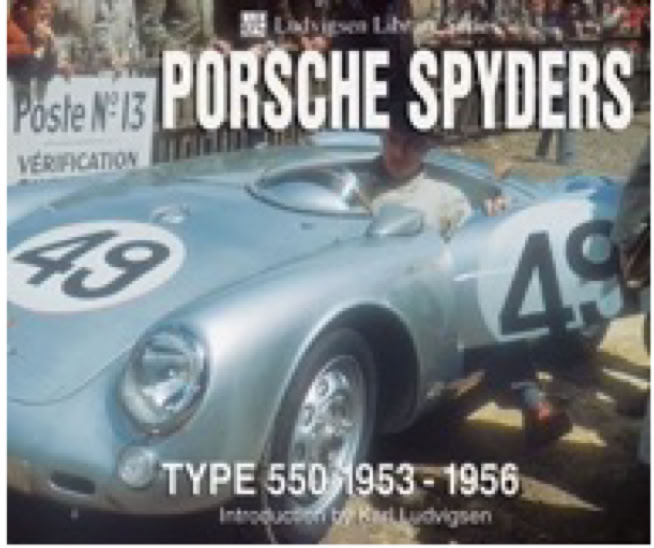
TITLE Porsche Spyders Type 550 1953-1956
AUTHOR Ludvigsen
ENGLISH
ISBN 10 1583880925
ISBN 13 9781583882009
NO LONGER AVAILABLE @ BLOCKS BOOKS
FROM MY REVIEWS IN THE 356 REGISTRY:
PORSCHE SPYDERS 550 1953-1956. Precisely as titled PORSCHE SPYDERS 550 covers only the earliest 550 Spyders (leaving hope for additional books covering the later 550A, 645 Mickey Mouse, RSK, RS 60-62 Spyders). It is in one sense a typical Iconographix published book (a couple pages of words by way of explanation and the rest of the book one/page black and white photographs with captions); in another way it is atypical -- you may rely on the facts. This, unlike a prior Iconographic effort, Porsche 356 1948-1965 Photo Album by Wyss, which consisted of about 100 photos from Herr Parr’s Porsche AG Arkivs and a fanciful history; PORSCHE SPYDERS 550 is primarily composed of contemporary photos taken by photojournalist Rudy Mailander, now part of the Ludvigsen library. Thus most the photographs are new; not the usual recycled fare. I can hardly get enough photographs of 550s, but the first pages on the 550-05 are amazing. Certainly, given the period is makes sense, but who would have thought: a 550 with early (Veigle like) VDO gauges. Photos of the wooden aerodynamic 1/5th scale model of the Buckelwagen (550-07) are juxtaposed to photos of the real cars. Rare, more precisely never before seen photos include the plastic tops on 550-07 and –08 –, which are almost targa, like. All of us know what Huschke von Hanstein looked like, but titled PORSCHE SPYDERS 550 identifies in multiple photographs Wilhelm Hild (the designer of the 550), Ernst Fuhrmann (the designer of the 547 motor) in plus fours, and even Hubert Mimler (550 mechanic and test driver). I had read about the seats on the first pre-production Spyders but had never seen photographs. The drivers seat looks like a Speedster bucket (don’t forget the 550 was designed contemporaneously with the Speedster) including square weave carpet back and twin vents, but with a significantly lengthened squab; while the passenger seat was a frame with wicker seating surfaces. Soft bound and at $24.95 list, as inexpensive as a current day book gets, PORSCHE SPYDERS 550 1953-1965 is a necessity for any Porsche book shelf.
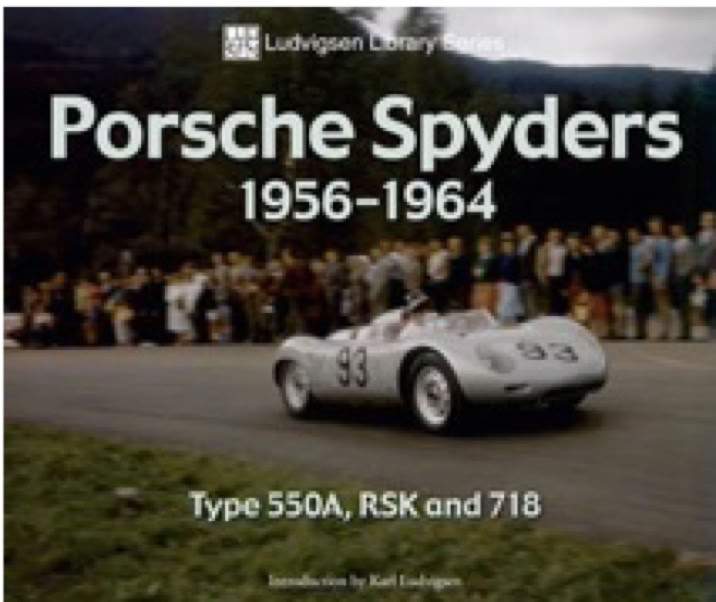
TITLE Porsche Spyders 1956-1964 Type 550A, RSK & 718
AUTHOR Ludvigsen
ENGLISH
ISBN 10 NO ISBN 10
ISBN 13 9781583880920
PRICE $29.00
1 AVAILABLE @ BLOCKS BOOKS
FROM MY REVIEWS IN THE 356 REGISTRY:
Karl Ludvigsen’s series of photographic books continues. Joining his 125 page Porsche Spyder Type 550 53-56 is his 125 page Porsche Spyders 550A, RSK, 718 1956-1964. The format of the two books, indeed of the hundreds of books in the Iconografix series, is identical: a couple page of introduction, 120 pages of contemporary black & white pages with captions. The photos are all from the Ludvigsen library. They are split between action shots and detail shots, mainly taken at the factory. Fascinating is the shoot of the of the RSK “surface cooling” hood with its welded oil serpentine on the underside. It didn’t work very well – there is also a shot of the air scoop in the sill (seen only on the factory cars) for the supplementary oil cooler. It’s absolutely amazing how many detail changes the Spyders underwent. Porsche Spyders 550A, RSK, 718 1956-1964, lists for $29.95. It deserves a place, on your book shelf, next to his Porsche Spyders Type 550 1953-1956.
TITLE Porsche 956 & 962 Immortal Endurance Racers 1982-1994
AUTHOR Ludvigsen
ENGLISH
ISBN 10 NO ISBN 10
ISBN 13 9781583882696
PRICE $27.00
LIST PRICE $32.95
STOCKED @ BLOCKS BOOKS
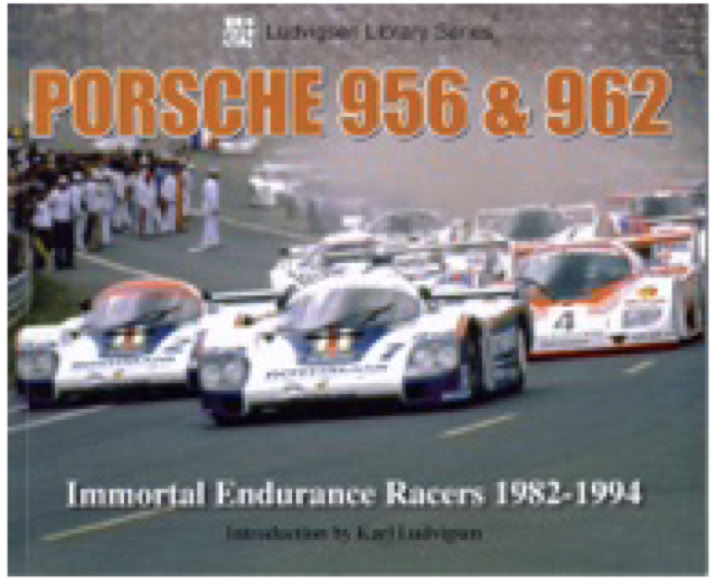
TITLE Porsche by Mainlander
AUTHOR Ludvigsen
ENGLISH
ISBN 10 no ISBN 10
ISBN 13 9871854432445
Price $120.00
List Price $150.00
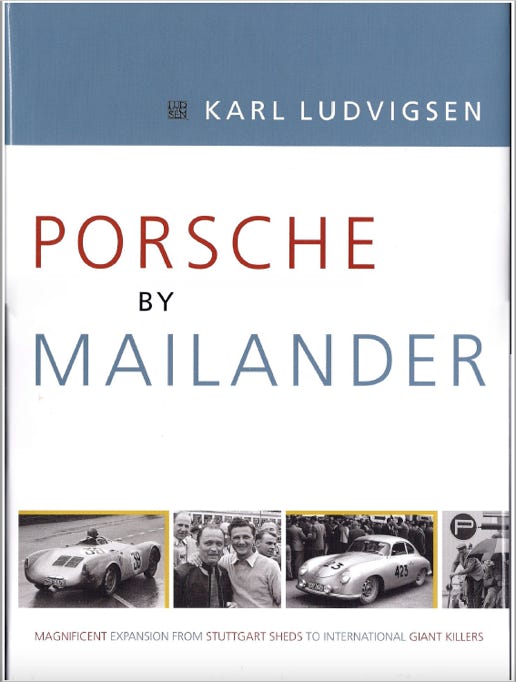
TITLE Porsche
Excellence Was Expected
ed 4
AUTHOR Ludvigsen
ENGLISH
ISBN 10 no ISBN 10
ISBN 13 9780837617695
Price $450.00
List Price $629..95
In 1976, when the original edition of EXCELLENCE WAS EXPECTED appeared, I probably was the first “civilian” to read the entire almost 800 pages – in three marathon nights. Not quite as good, the four volumes and almost 4000 pages has taken me four weeks.
Not only has EXCELLENCE been completely rewritten, but Karl Ludvigsen has changed the history from strict chronology to a focus chapters, generally on a specific model – while inserting temporally associated events. Of particular interest is chapter 18 Abarth Carrera and DKS. Karl finally lays rest the canard that Zagato built the Abarth-Carrera – apparently Carlo Abarth was anxious not to let Porsche know he had engaged a less expensive coachbuilder.
At close to 4000 pages, it should come as no surprise the book is loaded with Porsche technical drawings and photographs of models of which you have never heard.
Karl lists the engineers’ patents associated with development. I didn’t really appreciate this until I saw one of my friend’s listed as co-developer patent holder for the 964’s pistons associated with its twin-ignition. I called August at 9:30 at night to let him know he was in the book. August gave me a copy of the patent and told me Porsche paid a small sum to patent holders for each car produced.
No where else will you find inside Porsche information on Piech’s 4 cam engine family.
“I went from one race to the next, often traveling by night” Rudy Mailander was the premier race photographer of th early 50s; so much so that that Porsche’s business sales and business chief Albert Prinzing provided a 1.1 liter (later upgraded to 1/3) split window cabriolet. For the next 5 years Rudy photographed almost all the European races and rallies until hired by Mercedes then FIAT. Karl Ludvigsen purchased the Mailander photographs and 60 years later has written both Ferrari by Mailander and Porsche by Mailander. The Porsche by Mailander is large format (13x10x1.5”) 383 page, absolute cornucopia of of all things things Porsche PreA -- pre 356A and pre 550A -- races, rallies, factory, people. Simply not only the best documentation of Porsches prior to 1955 but a fabulous book.
New old stock boxed.
TITLE Porsche - Origin of the Species
AUTHOR Ludvigsen
ENGLISH
ISBN 10 0837613310
ISBN 13 9780837613314
NO LONGER IN STOCK @ BLOCKS BOOKS
Carl Ludvigsen certainly has the lock on spectacular and spectacularly informative Porsche history book: first, in 1978, Excellence Was Expected, now out as a three volume edition 2.1 – unquestionably the best marquee history ever written, followed by Genesis of Genius, which took us from Professor Ferdinand Porsche’s early years up to more or less the beginning of World War 2. Still awaited is a middle volume to filling this gap. Instead, we have Porsche Origin of the Species; which rather than be a standard chronological series draws together a series of sequential and parallel events, without any one of which there would be no Porsche.
Porsche father and son had always raced and been willing to spend un-booked company time designing cars. Sometimes this worked out, as with the design for Typ 22 Grand Prix car, which was purchased by Auto Union. Sometimes the designs appeared to be still born, as with the Typ 64 and Typ 114. Typ 64? I had taken it as an article of faith that the Typ 64 was the Porsche-side design number corresponding to the VW 60 10K – remember Typ 60 was Porsche’s design number for the initial VW. Carl argues that the Typ 64 was not, even for the time, a particularly advanced design. Apparently Porsche developed the 60 10K as a purely VW effort – remembering of course that Porsche supplied the entire design and engineering staff to VW. The Typ 114 was the influential body design, on top of a VW-like pan. From there is not difficult to see the evolution; via the tube frame 356/1 and then the 356/2 bent sheet metal with attached aluminum body to the final monocoque.
On two levels the Cisitalia contract, which included several designs in addition to the nascent
Grand Prix car is just as important. First, is the well-known use of the Cisitalia payments to ransom/bail the Professor from his French prison. Not know to me at least is that the French government refunded the bail several years later. According to Piech, by the time the bail was returned, inflation was such that the funds were sufficient to buy several pair of shoes. Yet another necessary strand was the observation of the Cisitalia 202 – an expensive small sports car built from FIAT parts. This combined with the 60 10K was a necessary epiphany. Porsche would use VW parts to make a small but expensive sports car. Porsche also had a large, somewhat under employed, staff of around 150 in Gmünd; and Porsche was not loath to use them on an un-booked project. Perhaps most important: currency reform had come about and VW was paying royalties. Porsche had a money problem -- not too little but too much with its attendant tax liabilities. What better way to create a tax write-off than to build cars? There are perhaps half a dozen other threads woven into the story I haven’t mentioned. It’s not just the history, which is superb and has an amazing number of new facts, but the understanding of how they all interrelated and how they all had to happen and happen at the right time.
Finally we have the Mathé/Seinfeld Gmünd T 2222 ; Porsche 356/2-040, an Austrian Werkes engineering car until December of 1953, was purchased by Otto Mathé, who had previously purchased the Typ 60 10k in 1950. This is important since effectively Mathé was the car’s only owner until his death fifty years later. Not clear is whether the car’s rough condition is the way Porsche built it or patina acquired during Mathé’s ownership. On one hand Carl relates the first Gmünd 356/2s shown in Switzerland had to be tarted-up to make them presentable and I was told while in Sweden Scania Vabis had to do the same with the last of Gmünd models. On the other hand, Otto Mathé was not one to baby his cars – while apparently never raced Porsche 356/2-040 was used as a tow car for his open wheel race car, and to this day wears a Werkes built roof rack for carrying tires. Unlike other high profie car T 2222 was not subjected to a restoration, but sympathetically gone through to make it safe to drive and close to original – for instance the reconversion to left had drive had been improperly executed. Now we get to the beauty of the book. The hstorical photographs come from the factory – one can’t help wondering how many “previously unpublished” photographs still lurk in the Arkivs. The fly leaf and chapter heading photographs are beautifully shot by Michael Furman whle Klaus Schnitzler, Professor of Photography at Monclair State University, shot most of the contemporary photographs. Adding perspective and relating valued antidotes are Paul Russel on the restoration and Chuck Stoddard on the historical background and his own Gmünd coupe. And up front following Jerry Seinfeld’s introduction is 356 Registry member, enthusiast and top flight automotive designer Freeman Thomas with “The Legacy of Erwin Komenda.” I always learn something from Freeman– in this case the distinction between “floating” and connected shut lines.
As should be expected for $110.00, the reproduction and paper quality are superb. The book is large format – about a foot square, 343 pages. The only down side of a book this thick, is the tendency for its binding to separate – much like the original Excellence Was Expected – NEVER fold the covers flat, ALWAYS read on your lap or a Vee book stand.

Orders cancelled for any reason are subject to a 3% charge to cover Paypal payment return fee.
